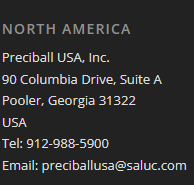Stainless steel balls are divided into 3 big families: Austenitic and Martensitic and Ferritic grades.
- Austenitic grades (stainless steel balls) are commonly in use for stainless steel application and are widely known as 300 series. They are the most corrosion resistant of the stainless steel grades. They are recommended when there is a food contact. They have a good resistance to water, oil, steam, alcohol, organic chemicals, oxidant solutions and a relative resistance to sulphuric acid compounds. They are not or lightly Ferro-magnetic. They are not hardened.
- Martensitic grades (stainless steel balls) are corrosion resistant and have higher hardness. These grades are Ferro-magnetic. They can be used in water, oil, steam, alcohol. They are mainly used where hardness, strength and wear resistance are required.
- Ferritic grades resist to corrosion and oxidation, and are resistant to stress corrosion cracking. These steels are Ferro-magnetic but cannot be hardened or strengthened by heat treatment. They are more corrosive resistant than the Martensitic grades, but inferior to the austenitic grades.
| Specification Stainless steel balls |
Equivalence Stainless steel balls |
Composition of stainless steel balls | |||||||
| C% | Si% | Mn% | P% max | S% max | Cr% | Mo% | Ni% | ||
| AISI 420 | DIN: W 1,4021 1.4031 ,1.4034 AFNOR: Z20C13 Z40C14 |
0.15min | 1max | 1max | 0.040 | 0.030 | 12/14 | ||
| AISI 440 | DIN: W1.4125 AFNOR: Z100CD17 |
0.60min
1.20max |
1.00max | 1.00max | 0.040 | 0.03 | 16/18 | 0.75max | |
| AISI 302 | DIN: W1.4310 AFNOR: Z10CN18-09 X |
0.15max | 1.00max | 2.00max | 0.045 | 0.015 | 17/19 | 0.8max | 8/9.5 |
| AISI 304(L) | W1,4301 UNI X5CrNi1810 AFN Z6CN18-09 |
0.07max | 1.00max | 2.00max | 0.045max | 0.03 | 17.00min
20.00max |
8.00min
11.00max |
|
| AISI 316(L) | DIN: W1.4401 (W1.4404) AFN Z6CND17-12 (Z2CND17-12) |
0.06max
(0.03max) |
1.00max
(1.00max) |
2.00max
(2.00max) |
0.045max
(0.045max) |
0.03
(0.03) |
16/18.5
(16/18.5) |
2/2.5max
(2/2.5max) |
10.5/13.5
(11/14) |
| AISI 904(L) | DIN: W1.4539 AFNOR: Z2CNDU25.20 |
0.020max | 0.70max | 2.00max | 0.030 | 0.010 | 19/21 | 4/5 | 24/26 |
| AISI 430 | DIN: W1.4016 AFNOR: Z8C17 |
0.08max | 1.00max | 1.00max | 0.040 | 0.030 | 16/18 | ||
| Specification (stainless steel balls) |
Hardness | Density |
| AISI 420 | 55/58 Hrc | 7.75 |
| AISI 440C | 58/64 Hrc | 7.75 |
| AISI 302 | 25/39 Hrc | 7.93 |
| AISI 304(L) | 25/39 Hrc | 7.93 |
| AISI 316(L) | 25/39 Hrc | 7.98 |
| AISI 904 | 150/300 HV | 8 |
| AISI 430 | 135/380 HV | 7.68 |
Role of carbon in stainless steel balls:
Manufacturing steel balls requires the presence of carbon. This enables, in particular, the formation of cementite and perlite. The more carbon there is in stainless steel balls, the harder they will be. Furthermore, this factor also influences the resistance of the balls to wear.
Role of niobium in stainless steel balls:
In ferrous stainless steels, the addition of niobium is one of the most effective methods for improving an alloy’s thermal resistance. The addition of niobium helps to reduce corrosion for the stainless steel balls, especially in hot areas of use. Therefore, it acts as a stabiliser.
Role of titanium:
The addition of titanium improves resistance to pitting. Titanium is considered to be a stabiliser in the alloy of stainless steel ball.
Role of manganese in stainless steel balls :
Manganese is often used to replace nickel. Manganese reacts with oxygen and, therefore, acts as an antioxidant. It influences the behaviour of steel and, in particular, its ability to harden.
Role of chrome in stainless steel balls:
Chrome serves, in particular, to increase the stainless steel ball’s hardness and resistance to wear. Chrome is also recognised for its corrosion resistant properties. Steel containing more than 12% of chrome is considered to be stainless steel.
Role of silicon in stainless steel balls:
Silicon plays an antioxidant role in steel. Also, its association with other alloys makes steel even more hard-wearing. Small amounts of silicon are added to steel to improve resistance to corrosion. Silicon is commonly added to stainless steel to improve its resistance to oxidisation.
Role of nickel in stainless steel balls:
Nickel offers excellent ductility and tensile strength. These properties are maintained at very cold (cryogenic) temperatures. Nickel favours the formation of a homogenous austenitic structure for the stainless steel balls.
Role of molybdenum in stainless steel balls:
Molybdenum is used in stainless steel up to a density of 8%, but most often in a range from 2 to 4%. Even at a lower rate, molybdenum ensures a powerful effect in improving the alloy’s strength.




